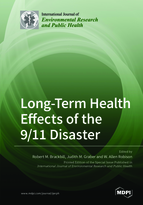Long-Term Health Effects of the 9/11 Disaster
A special issue of International Journal of Environmental Research and Public Health (ISSN 1660-4601). This special issue belongs to the section "Environmental Health".
Deadline for manuscript submissions: closed (28 February 2019) | Viewed by 88334
Special Issue Editors
Interests: 9/11; public health; environmental epidemiology; psychiatric epidemiology; long term health effects of disaster related trauma; disaster preparedness
Special Issues, Collections and Topics in MDPI journals
(2) Environmental and Occupational Health Sciences Institute, Rutgers, The State University of New Jersey, Piscataway, NJ, 08854, United States
Interests: Occupational cancer; Dust exposure; Emergency responders; Total worker health; Epidemiology methods
Special Issues, Collections and Topics in MDPI journals
Interests: exposure assessment; toxicology; disaster preparedness; occupational safety and health; risk assessment
Special Issue Information
Dear Colleagues,
The International Journal of Environmental Research and Public Health is planning on publishing a Special Issue on the “Long-Term Health Effects of the 9/11 Disaster”. The terrorist attacks on the World Trade Center towers, on September 11, 2001, also referred as 9/11, was an iconic event in US history that altered the global and political response to terrorism. The attacks which involved two planes hitting the twin towers in Lower Manhattan in New York City resulted in the collapse of the buildings and over 2800 deaths of occupants of the buildings, fire, police and other responders and persons on the street in the vicinity of the collapsing buildings. The destroyed towers and the surrounding buildings have since been replaced but the health effects that resulted from the release of tons of dust, gases and debris as well as the life threat trauma are ongoing and represent a major health burden among persons directly exposed. Hundreds of scientific publications have documented the physical and mental health effects attributed to the disaster. The current state-of-the-art in understanding the ongoing interactions of physical and mental health, especially PTSD, and the unique mechanisms by which pollutants from the building collapse have resulted in long term pulmonary dysfunction, course of previously reported conditions, potential emerging conditions (e.g., heart disease and autoimmune diseases), as well as quality of life, functioning and unmet health care needs would be in the purview of this Special Issue on 9/11 Disaster.
Dr. Robert M. Brackbill
Dr. Judith M. Graber
Dr. W. Allen Robison
Guest Editor
Manuscript Submission Information
Manuscripts should be submitted online at www.mdpi.com by registering and logging in to this website. Once you are registered, click here to go to the submission form. Manuscripts can be submitted until the deadline. All submissions that pass pre-check are peer-reviewed. Accepted papers will be published continuously in the journal (as soon as accepted) and will be listed together on the special issue website. Research articles, review articles as well as short communications are invited. For planned papers, a title and short abstract (about 100 words) can be sent to the Editorial Office for announcement on this website.
Submitted manuscripts should not have been published previously, nor be under consideration for publication elsewhere (except conference proceedings papers). All manuscripts are thoroughly refereed through a single-blind peer-review process. A guide for authors and other relevant information for submission of manuscripts is available on the Instructions for Authors page. International Journal of Environmental Research and Public Health is an international peer-reviewed open access monthly journal published by MDPI.
Please visit the Instructions for Authors page before submitting a manuscript. The Article Processing Charge (APC) for publication in this open access journal is 2500 CHF (Swiss Francs). Submitted papers should be well formatted and use good English. Authors may use MDPI's English editing service prior to publication or during author revisions.
Keywords
- 9/11 Disaster
- Physical and mental health
- PTSD
- Pulmonary dysfunction
- Quality of life






